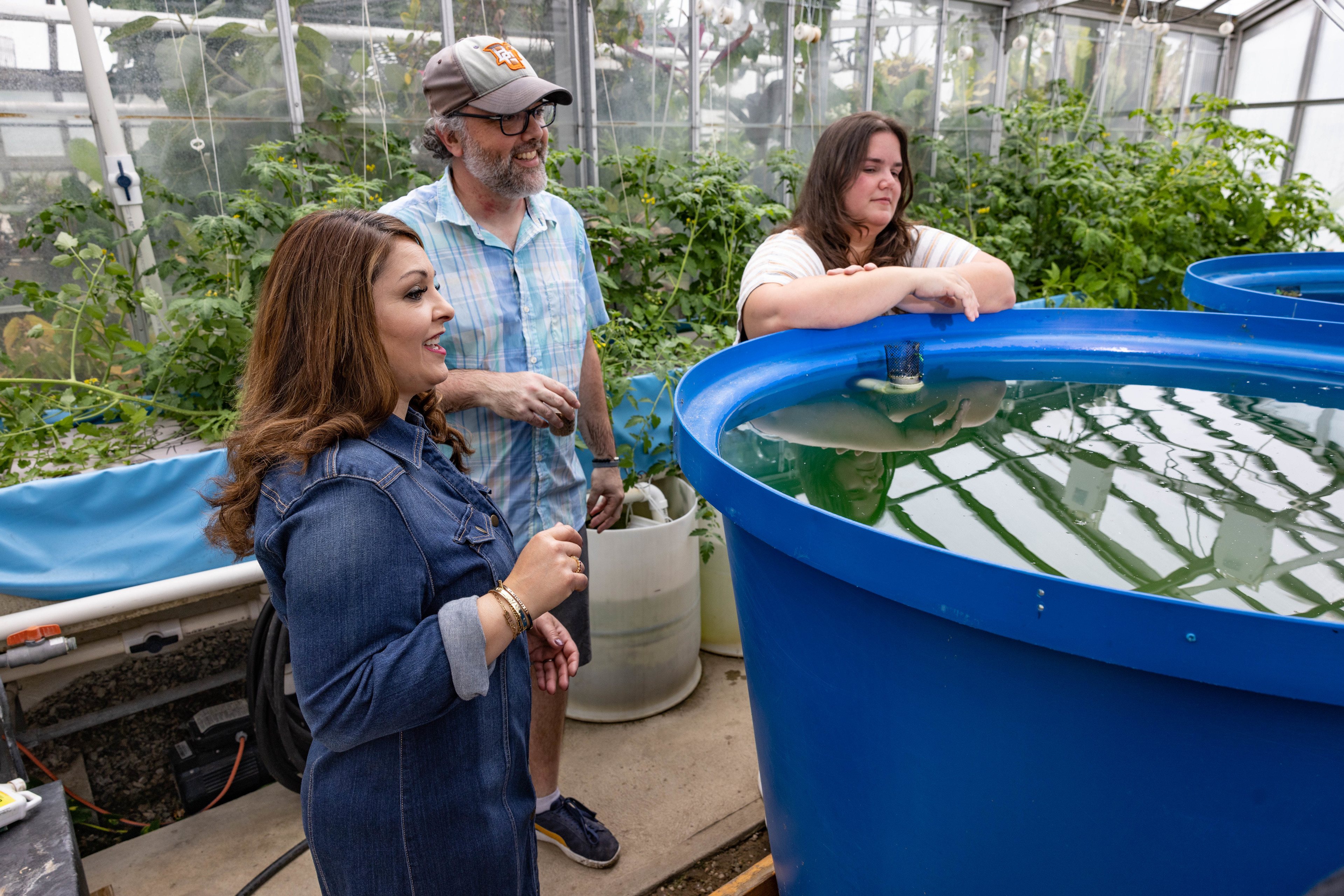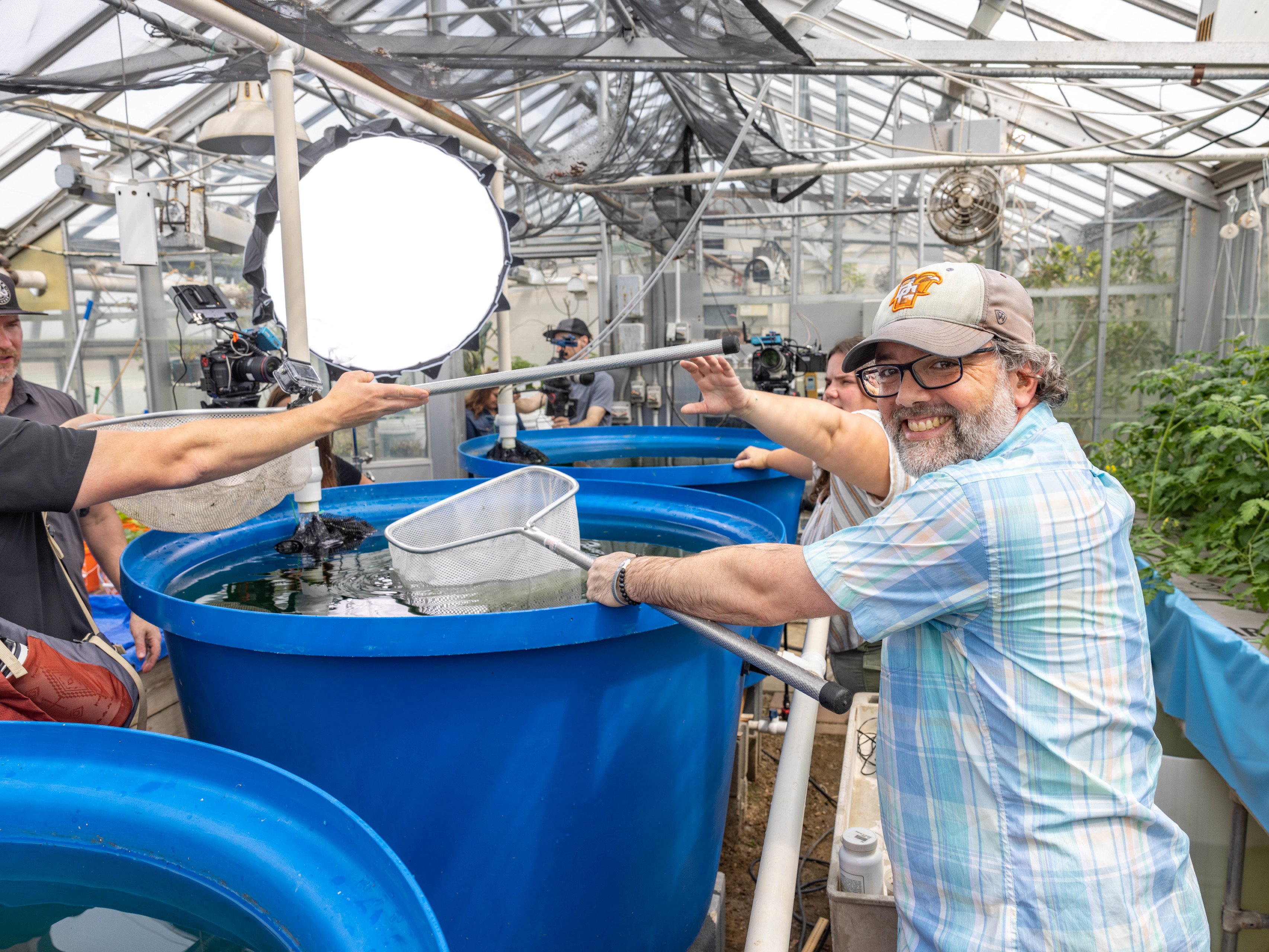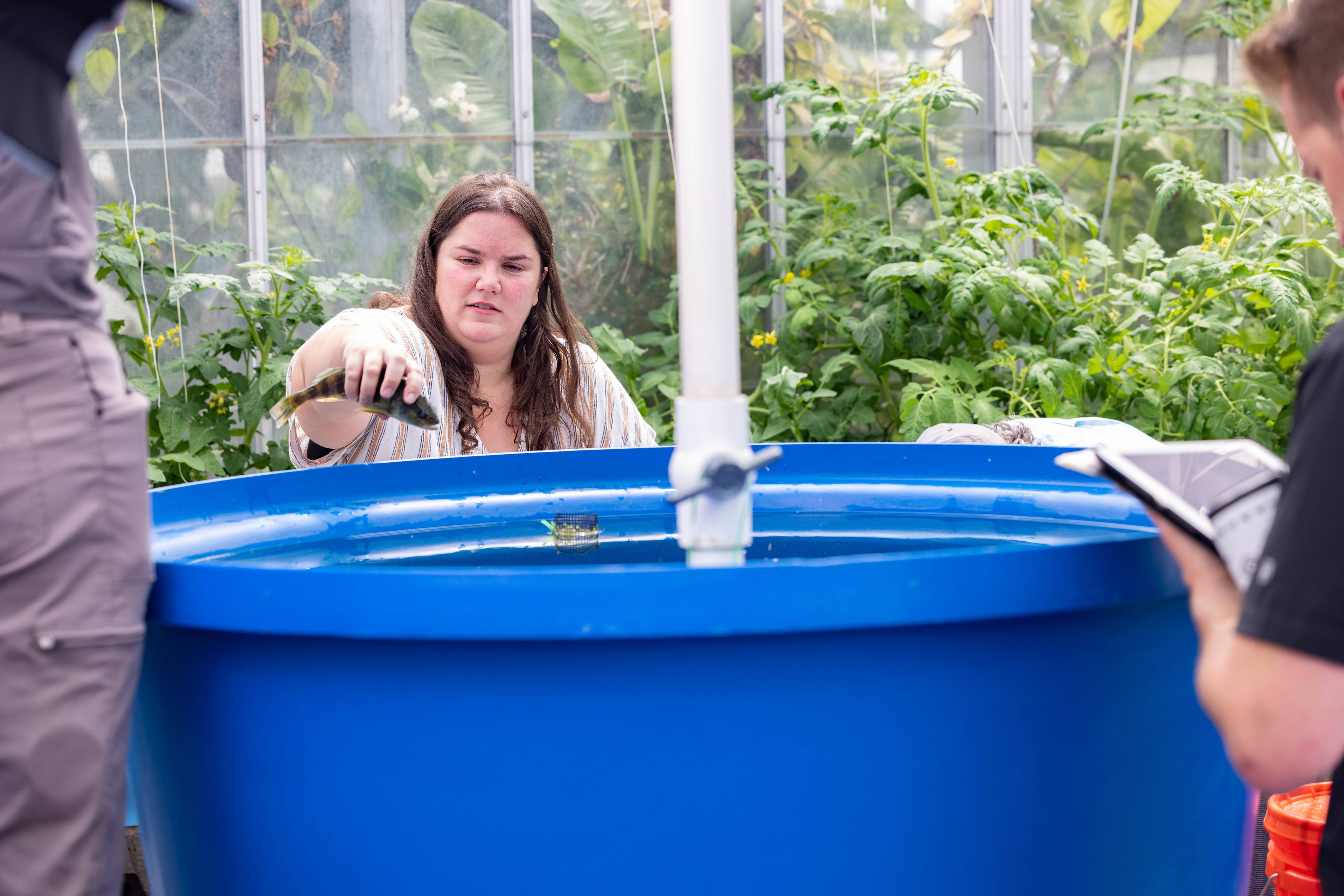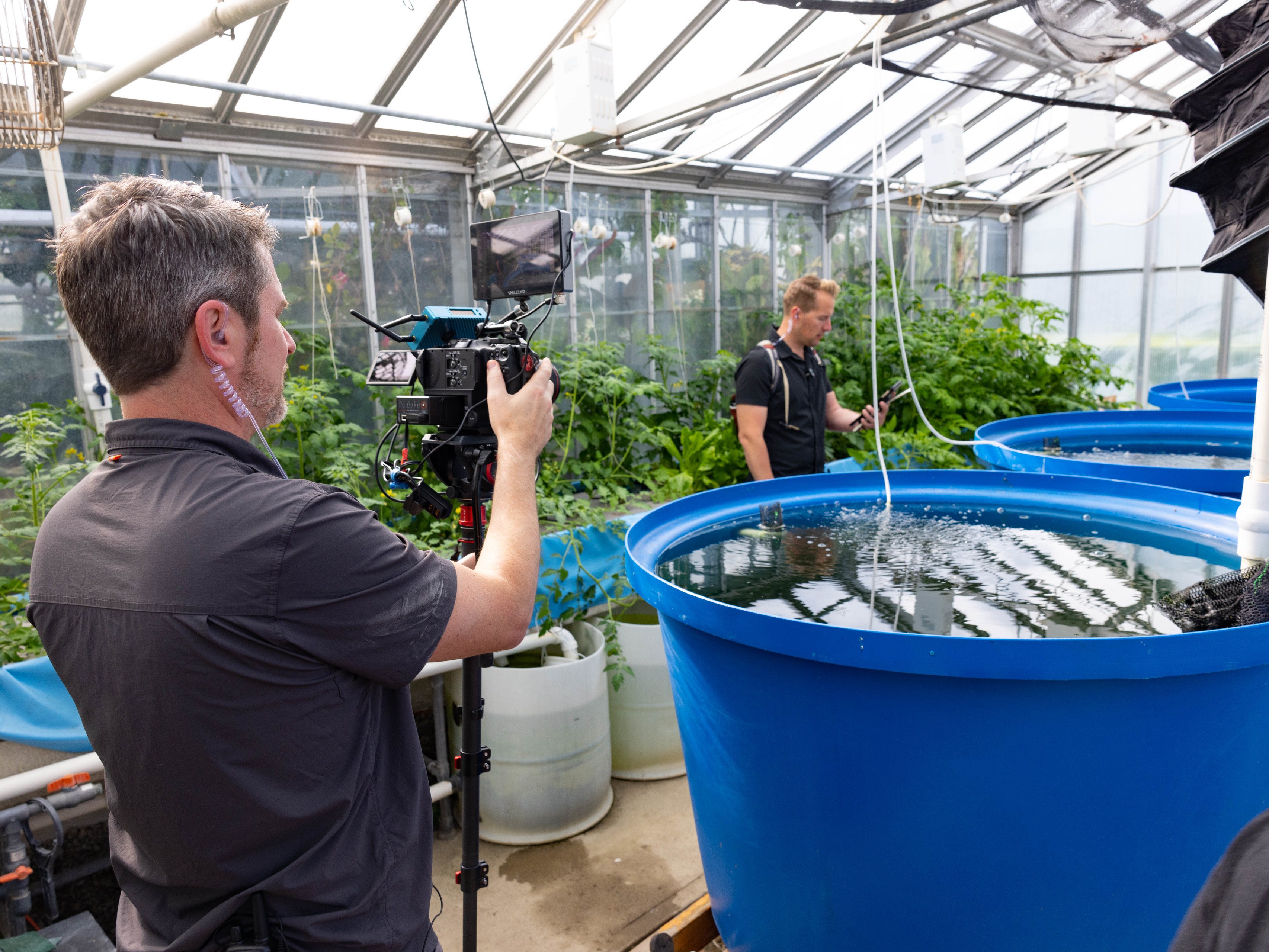
Aquaponics research at BGSU pioneers sustainable solutions for a greener future and gains attention from PBS series
Estimated Reading Time:
Upcoming documentary 'America the Bountiful' to showcase the production of culturally significant yellow perch and the innovative solutions for sustainable agriculture and environmental conservation.
By Victoria Dugger
Tucked away in an unassuming building on the campus of Bowling Green State University, a groundbreaking initiative is underway, spearheaded by marine biology instructor Dr. Kevin Neves and master of science graduate student Maria D'Amico '22. Their innovative research in aquaponics is not only transforming traditional views of farming but also paving the way for a more sustainable and environmentally friendly future.
Aquaponics, a sustainable farming method that combines aquaculture and hydroponics, is at the core of Neves and D’Amico's work. This method harnesses the symbiotic relationship between aquatic animals and plants, creating a closed-loop system where fish waste serves as a nutrient source for plant growth, while the plants act as natural filters, purifying the water for the fish. This recirculating system is capable of raising Lake Erie fish and crops like lettuce and tomatoes at the same time.
Their work has garnered attention beyond the academic realm, with PBS expressing interest in featuring their research in the documentary series "America the Bountiful." This recognition underscores the significance of their contributions to the field of aquaponics and their potential to inspire positive change on a national scale.
"America the Bountiful" will feature the University's perch-growing operation as part of its exploration of culturally significant regional foods - in this case, yellow perch and its significance to Ohio - and sustainable farming practices across the nation when its second season debuts in early 2025.
The setup, housed inside the BGSU greenhouse, involves three large tanks -- two are filled with yellow perch and one is filled with crayfish. Water from the tanks flows into a 5-by-20-foot trough that supports plants - tomatoes and lettuce - on floating panels, with their roots submerged underwater. This results in a multiculture of fish, shellfish and vegetables all being raised with the same amount of resources.
An important feature of this closed system is that it results in no nutrient runoff because the water is filtered and recirculated without leaving the system. The benefit is there is no risk of nutrients entering surface water and potentially contributing to the growth of harmful algal blooms in a watershed.
An additional benefit is the volume of food that can be produced. In a span of six months, the pilot program produced 200 pounds of tomatoes and about 50-100 pounds of yellow perch.

Neves, an assistant teaching professor in the Department of Biological Sciences at BGSU, explains the significance of their aquaponics research: "Our integrated multi-trophic aquaponics system represents a novel approach to sustainable agriculture. By harnessing the natural processes of aquatic ecosystems, we're able to produce food in a way that minimizes environmental impact and maximizes efficiency."
D'Amico, a passionate advocate for freshwater conservation, echoes this sentiment: "Aquaponics offers a unique opportunity to address environmental challenges, such as water scarcity and pollution. Through our research, we're not only finding innovative ways to grow food but also contributing to the preservation of freshwater ecosystems."
D’Amico, of Cleveland, serves as a graduate research and teaching assistant in the Neves Lab and has been an aquaponics research supervisor since April 2021. She earned her bachelor’s degree in biology, ecology and conservation biology from BGSU in 2022 and became a member of the BGSU subchapter of the American Fisheries Society after seeing the society’s efforts to make campus both a greener and better place to live for both humans and local wildlife. She is on track to complete her master’s degree in 2025.

The aquaponics system developed at BGSU utilizes freshwater fish and crayfish to help grow plants in a mutually beneficial relationship. Fish waste is converted into nutrients by the crayfish, which is then used to fertilize the tomato and lettuce plants. This integrated approach not only maximizes resource utilization but also minimizes waste production, making it a truly sustainable farming method.
"Aquaponics addresses several significant problems. It provides a sustainable source of food production, whether it’s the tomatoes or the yellow perch we grow," Neves said. "The system is designed to be as natural as possible, without relying on fertilizers or pesticides, using only tap water. This makes people feel confident about the safety and nutrition of their food. Historically, concerns about wild fish from the Lake Erie watershed have been significant, but our system offers a safe, nutritious and tasty alternative."
What sets Neves and D'Amico's research apart is its scalability and adaptability. Their system can be implemented in a variety of settings, from urban environments to rural communities, offering a viable solution to food production challenges faced worldwide. This technology can be developed in areas with low water availability, food deserts or developing countries. It’s accessible and requires little technical expertise, making it feasible for many people.
"We envision a future where aquaponics plays a central role in sustainable agriculture," Neves said. "By harnessing the power of nature, we can create a more resilient and efficient food system that benefits both people and the planet."

When the PBS filmmakers visited the greenhouse in May, Neves and D'Amico presented the perch they produced and wild-caught perch to them for a blind, side-by-side taste test. The difference was imperceptible, Neves said.
"That's all I want. We have never set out to say aquaponics is going to produce the best fish you've ever eaten," Neves said. "We're just hoping that the average person can't tell the difference between aquaponics and wild and our fish is imperceptible."
As D'Amico reflected on her journey, she emphasized the importance of both the hands-on experiential learning and mentorship she has experienced at the University as an undergrad and graduate student.
"BGSU has provided me with invaluable opportunities to explore my passion for freshwater ecology and aquaponics. Working alongside Dr. Neves and being part of the aquaponics research team has been a transformative experience, shaping my career path and fueling my commitment to environmental conservation," she said.
Part of that experience has included remarkable milestones in her academic and research journey. With a passion for freshwater conservation, she has played a pivotal role in the development and execution of an aquaponics project with Dr. Silvia Newell, now director of Michigan Sea Grant, which was presented at Aquaculture America, an international conference. Her expertise earned her the prestigious first-place prize in the student poster presentation category for her discussion of "Assessing Nitrogen Dynamics in a Closed, Integrated Aquaponics System."
Neves holds a Ph.D. from the University of Maine, and his research interests include aquaponics, carbon dioxide, water quality, integrated multi-trophic aquaculture, otolith development and fish nutrition. His lab focuses on the development of integrated multi-trophic aquaponics systems and fish physiology.
In a world faced with mounting environmental challenges, the aquaponics research at BGSU stands as a sign of promise and progress. Through innovation, collaboration and dedication, Neves, D'Amico and their team are paving the way for a greener, more sustainable future and serve as a testament to the impact of research-driven solutions at BGSU in shaping a brighter future for generations to come.
Related Stories
Media Contact | Michael Bratton | mbratto@bgsu.edu | 419-372-6349
Updated: 06/13/2024 12:47PM




